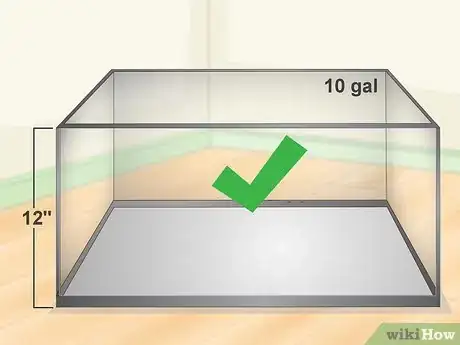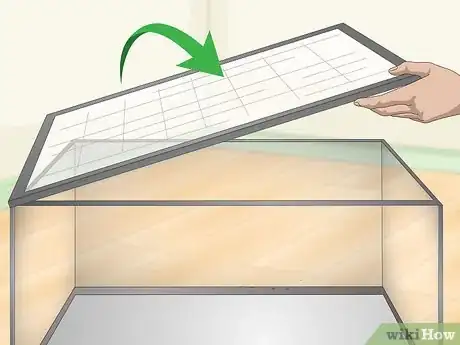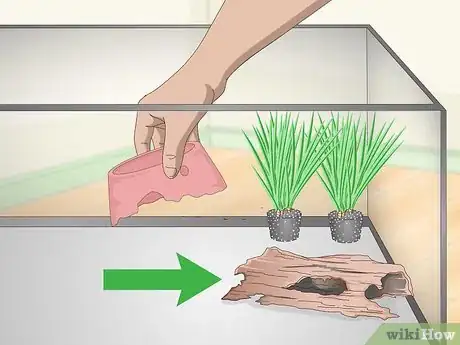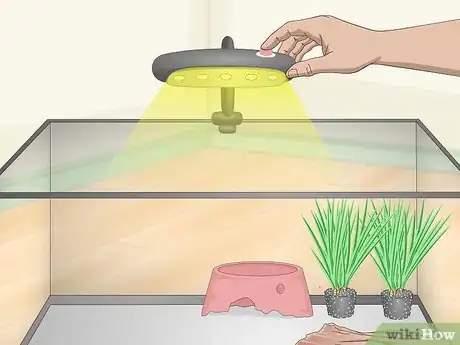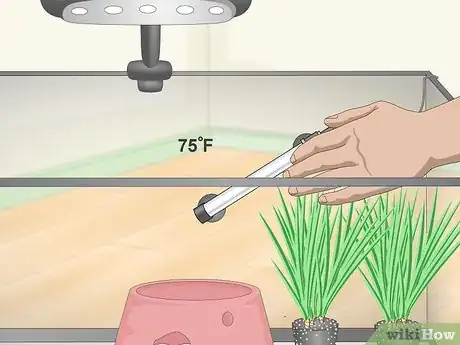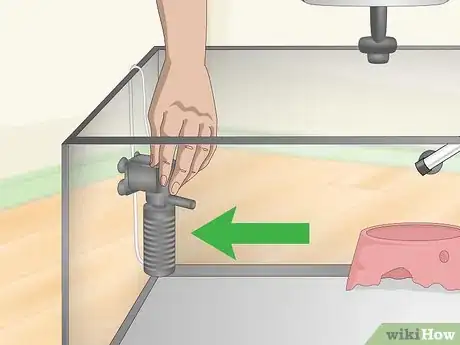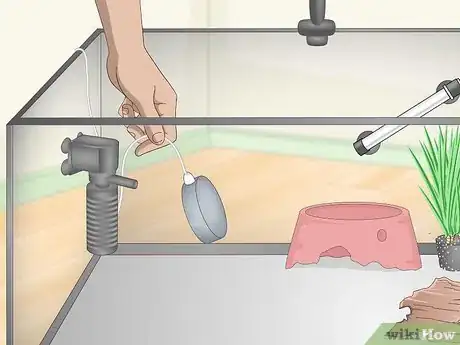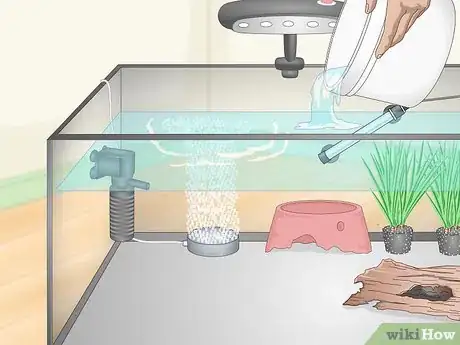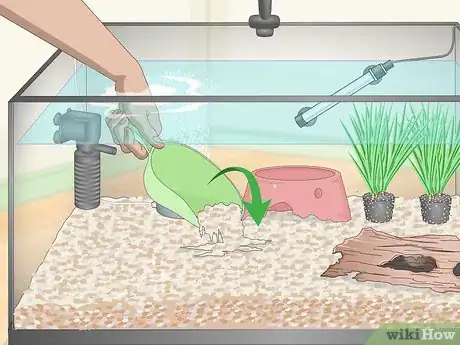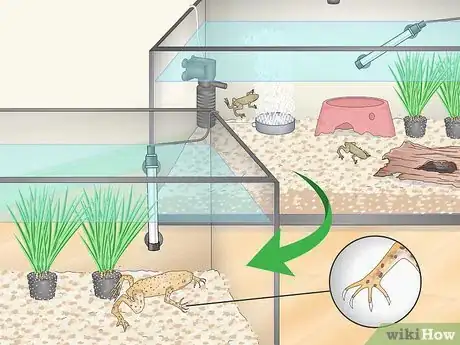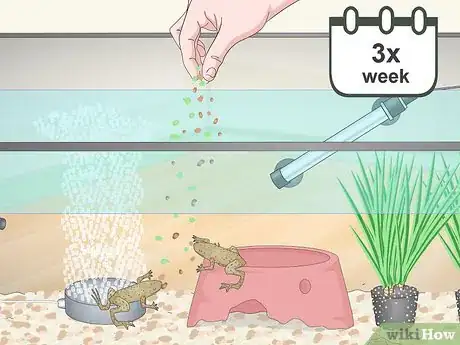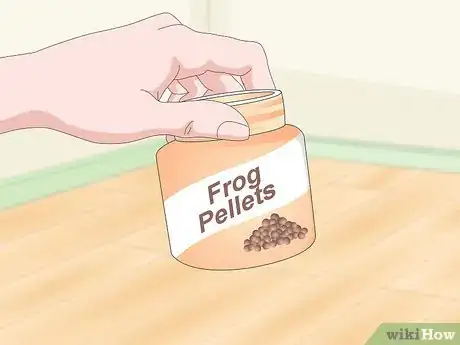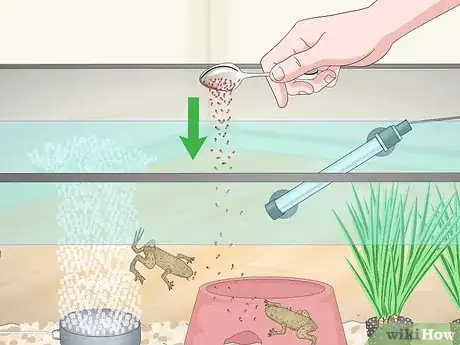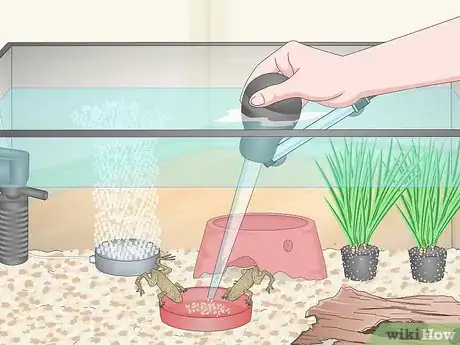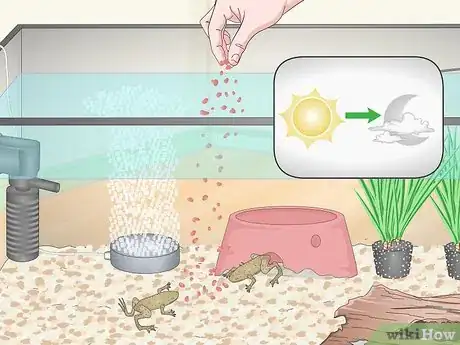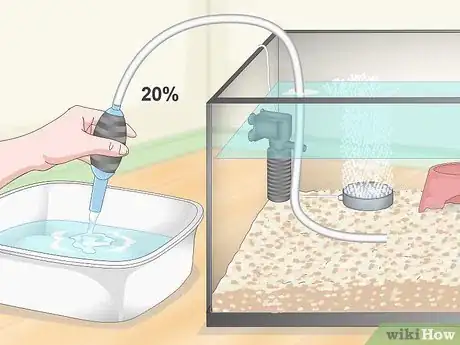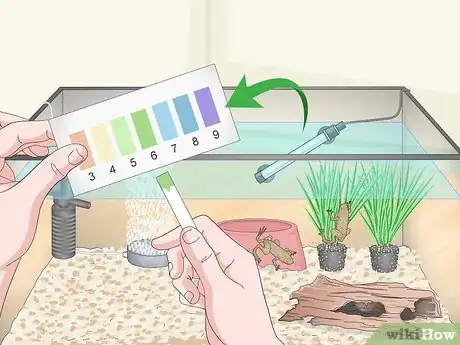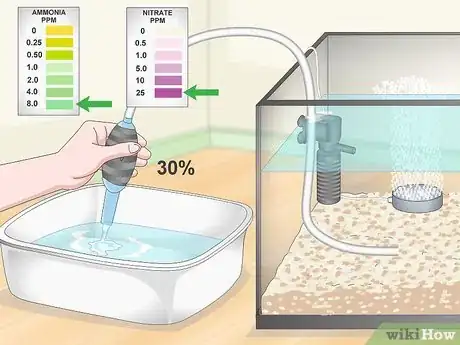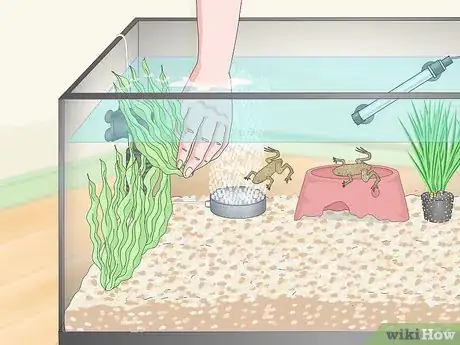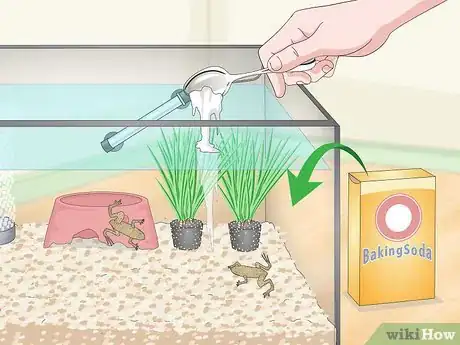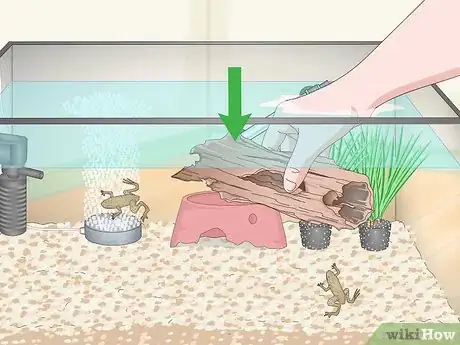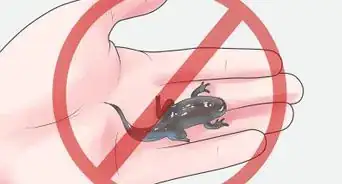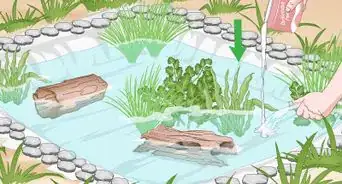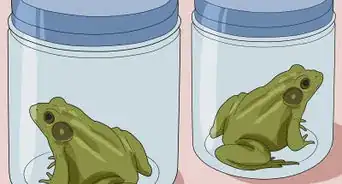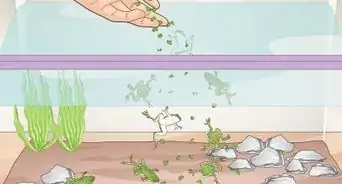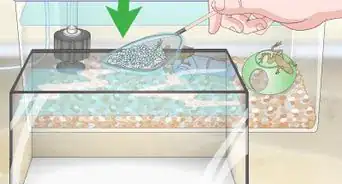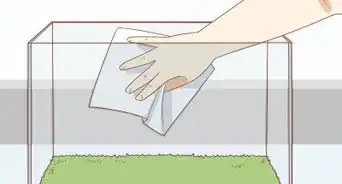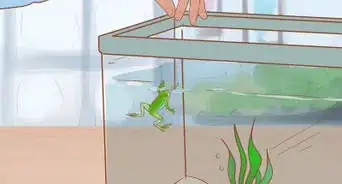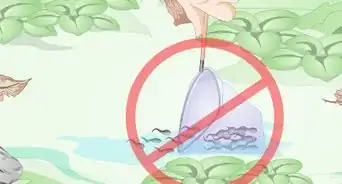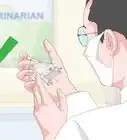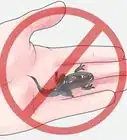This article was co-authored by wikiHow Staff. Our trained team of editors and researchers validate articles for accuracy and comprehensiveness. wikiHow's Content Management Team carefully monitors the work from our editorial staff to ensure that each article is backed by trusted research and meets our high quality standards.
wikiHow marks an article as reader-approved once it receives enough positive feedback. In this case, 92% of readers who voted found the article helpful, earning it our reader-approved status.
This article has been viewed 133,125 times.
Learn more...
Aquatic frogs are fun, low-maintenance animals, ideal for someone who doesn't have a lot of time on their hands but would still love to have a pet. As an added bonus, the frogs fit into small places, ideal for the home with little space. Their care requirements are simple, although they are very different from those of fish.
Steps
Creating the Perfect Frog Habitat
-
1Use a 10 gallon (38 L) tank that is no more than 12 in (30 cm) deep. Your frog will need enough space to move around with ease. If you have more than one frog, you will need an extra 1 gallon (3.8 L) per frog. The more space, the better.
- Aquatic frogs, especially dwarf frogs, are not particularly strong swimmers, but they do need to come up to the surface of the water to breathe regularly. Anything deeper than 12 inches (30 cm) will make it too difficult for your frog to surface.
- If the tank is crowded, it will not only cause stress to your frogs, but it will also mean you will have to clean the water more often.
-
2Install a tank cover with no openings. Aquatic frogs like to jump. If there are any openings in the top of your tank, they may jump out of your tank. Aquatic frogs will die if they are outside their water habitat for more than 15-20 minutes.
- Even small openings in the tank lid for filters or air lines may be big enough for your frog to hop through. Be sure you get a lid that has covers for any unused holes, or buy the covers separately.
- Some aquarium covers come with plastic on the back side where you can cut small openings for any wires or tubing that needs to go into the tank. Cut the holes so they fit the wires or tubes very snugly so the frogs won’t be able to get out that way.
Advertisement -
3Give your frogs a variety of hiding places. Aquatic frogs feel more happy and secure if they have somewhere to hide. Use aquarium decorations or shelters specifically designed for aquatic frogs. You can also use live plants or soft artificial ones.
- Try using unpainted clay flower pots lying on their side in the tank. This is a perfect hiding place for your frogs, and it’s an easy and budget-friendly solution for you.
- Don’t use anything in the tank that is painted or glazed. Some of the chemicals can leach out into the water and poison your frogs.
-
4Add a standard aquarium light. Aquatic frogs don’t need fancy basking lights like reptiles do. However, they do need regular periods of light and dark to mimic their natural outdoor habitats. You can buy a regular aquarium light and a timer set to give the frogs 10 hours of light per day.
- LED aquarium lights are long lasting and energy-efficient.
- While most tank plants will thrive under LED lights, if you have a more exotic plant, like Ammannia crassicaulis or other plants that require high lighting to thrive, check with your local aquarium supplier to find out if you might need to get a special plant light to keep it happy.
-
5Keep the frogs comfortable by heating the water to at least 75 °F (24 °C). Aquatic frogs prefer a water temperature around 78 °F (26 °C). You can either always keep the room where the frogs live at 80 °F (27 °C) or find an aquarium heater at your local pet store or aquarium specialist.
- Many aquarium heaters attach to the inside of the aquarium and must stay fully submerged in the water.
- If you want to free up more space inside your aquarium for plants and inhabitants, get an in-line external heater that sits on the outside of the tank. It’s also a good option if you have a lot of plants in your tank. The submersible heaters are not as effective at circulating the warmth in a heavily planted space.
-
6Use an aquarium filter for fewer water changes. A filter will help keep the water clear and balanced. With a water filter, you will only need to change the water when the nitrate levels get too high.
- Aquatic frogs are very sensitive to noise. Because of this, filters that sit inside the tank can be far too loud for them. Use an external canister filter instead. Find it at your local aquarium supply store. Place noise-absorbing padding under the filter to reduce the vibration and noise in the tank itself.
- Be sure your frogs’ legs can’t get sucked into the inlet slots or holes for the filter. If in doubt, find an intake sponge at your local aquarium supply and place it over the intake hole.
-
7Add an aerator, especially if there are fish in the tank. Because frogs come up to the surface for air, they don’t absolutely need an aerator, but installing one will keep your tank water healthy by encouraging good bacteria to thrive. It is also necessary if you have fish or shrimp or any other creatures breathing with gills living in the tank.
- Buy a standard air pump and an air stone at your local aquarium supplier.
- An aerator can also be a source of entertainment for your frogs. Many of them like to play with the air bubbles.
- The hum of the air pump can irritate the frogs’ sensitive ears. Try to isolate the pump by hanging it from a nail in the wall so it doesn’t touch the wall or the side of the tank.
-
8Fill the tank with conditioned water. Put room temperature, non-chlorinated water into the tank. Fill the tank until it is three quarters (3/4) full. Attach and activate your lights, heater, and aerator.
- If you are using spring water that you know has no chlorine or chloramines, all you will need to do is add a starter bacteria additive. Find one at your local aquarium supplier for small aquatic habitats. This will introduce healthy bacteria to your water and make it ready for the frogs.
- Use a dechlorinator to remove any chlorine or chloramine from the water, both of which are harmful to frogs.
- If don’t have a dechlorinator and you know for sure that your water only has chlorine (and not chloramine), you can let your tank sit undisturbed for 48 hours to let the chlorine evaporate before adding your frogs.
-
9Add a substrate to make your tank more attractive. Frogs don’t need to have anything covering the bottom of the tank, but it can be visually appealing. Buy a colorful aquarium gravel in a color that contrasts with your frogs so you can see them better.
- If you do use a substrate, buy an aquarium vacuum cleaner so you can vacuum out any bits of food or other debris every week so it doesn’t get stuck in the gravel and rot.
-
10Keep clawed frogs in a tank separate from other species. The most common aquatic frogs are the African dwarf frog and the African clawed frog. Their care requirements are the same, but the clawed frog should not share the aquarium with other species. You can easily house dwarf frogs along with small aquarium fish or shrimp.[1]
- Dwarf frogs have webbed fingers on their front legs.
- Clawed frogs have no webbing on their front feet.
- Dwarf frogs are under 2 inches (5.1 cm)in length, whereas clawed frogs can reach a size of 5–8 inches (13–20 cm) as adults.
- Although you should never release any pet into the wild, this is especially true for clawed frogs. They are extremely predatory, invasive species.
Feeding the Frogs
-
1Feed your frogs until they are full 3 times per week. Pick three non-consecutive days per week (Monday, Wednesday, and Friday, for example) to feed them. Give them as much food as they will eat in about 15 minutes. You will have to experiment a bit to find the right amount. Remove any uneaten food from the tank with a net or aquarium vacuum after 20 minutes so it doesn’t start to rot and dirty the tank water.
- Frogs are opportunistic feeders, which means they will always eat if they find food. That’s why if you feed them every day, they will become overweight.
- You can also add ghost shrimp to the tank to help you clean up any unwanted food. They are better at scavenging for food at the bottom of the tank than the frogs are, so they will find any tiny bits of food that the frogs and your vacuum or net might miss. Be sure to buy large shrimp because the frogs will eat shrimp if they can get their hands on them (and fit them into their mouths).
- If you are using a commercial aquatic frog food, remember to follow the dosage instructions on the label.
-
2Purchase commercial frog pellets or sticks. Commercial foods are usually manufactured for aquatic turtles, newts and frogs. You can find it at most pet stores. Check the feeding instructions on the label for the correct feeding amount.
- Average-sized frogs usually need 3-6 sticks per meal. Break the stick in half to make it easier for them to swallow.
- Most pellets will specify 3 or 4 pellets per frog, per meal.
-
3Add variety to your frogs’ meals. Commercial frog food will ensure that your frogs get the right nutrients. However, once or twice per week you can feed your frogs something more exciting instead of the commercial pellets or sticks. Try live or frozen brine shrimp, frozen bloodworms, finely chopped earthworms, or tiny pieces of frozen beef heart.
- For example, if they are being fed on Mondays, Wednesdays, and Fridays, try giving them a meal of commercial pellets or sticks on Monday (when they are the most hungry because they haven’t eaten over the weekend), then feed them special frozen foods on Wednesday and Friday.
- Talk to your local aquarium specialist to find the right alternative food for your budget and your frogs.
- Live bloodworms have hooks that can injury your frogs’ throats, so be sure to only feed them the frozen variety.
- Check the dosage recommendations on the frozen food you buy. Most come in small frozen cubes. One cube is usually enough to feed 3 frogs for one meal. Cut the cubes with a knife warmed under hot water.
-
4Place the food at the bottom of the tank. Use a turkey baster to put the food directly onto the bottom of the tank. You may want to use a small terra cotta dish to put the food on so the frogs will always know where to find it.
- If your tank has filtration and aeration that results in a lot of water movement in the tank, the food will not stay on the terra cotta dish. In this case, simply put the food on the bottom of the tank for the frogs to find on their own.
- Frogs don’t have great vision, so they may not realize there is food for them before it starts to spoil. To help them out, gently tap on the glass 3 times every time you are about to give them food. They will learn that the tapping means they should get ready to look for food.
- If you have fish in your tank, it’s especially important to place the food at the bottom where the frogs can easily get to it. If you simply sprinkle the food on the top of the water, the fish will eat most of it before it gets down to the frogs.
-
5Start by feeding the frogs during the day, then switch to nighttime feeding. Although frogs are somewhat nocturnal, they can easily adapt to being fed during the day. It’s also easier for you to gauge how much food they are eating if you feed them when their aquarium light is on. Once you get the hang of how much they eat, you can switch to feeding them as soon as their light turns off in the tank to simulate their wild environment.
Keeping Optimal Conditions in the Tank
-
1Replace 20% of the water and rinse your filter every 14 days. To do this, use an aquarium water change kit from your pet store. Turn off the filter, take it out, and rinse it with some of the tank water to clear out any debris. Set everything up just as you did when you first got your frogs. Refill the tank ¾ full with conditioned water and add a starter bacteria additive.
- Take out and clean any accessories in the tank with tank water and a scrubbing brush.
- You can also use a small bucket to scoop water out of the tank.
-
2Check the water chemistry weekly with an aquarium water test kit. Find the test kit in your local pet store or online. The kit will measure the levels of ammonia, pH, nitrate, and nitrite. Fill the provided test tubes with water from your tank, add the test drops according to the instructions, and then compare the results to the color card in the kit. Follow any recommended care instructions on the card.
- You can also use aquarium water test strips, which are a bit easier to use, but will be more expensive in the long-run.
-
3Replace 30% of the water if the ammonia or nitrite levels are high. If your water test kit shows that you need to lower the ammonia levels slightly, or lower the nitrite levels, start by replacing 30% of the water with fresh, conditioned water and cleaning out any debris in the tank. You can also increase the aeration of the tank to help prevent the problem in the future.[2]
- You may want to buy some neutralizing drops from your local pet store. Although they won’t fix the imbalance, they will neutralize the negative effects on your frogs and other inhabitants.
-
4Add plants to the tank to reduce nitrate levels. Although nitrates are not as harmful to frogs as ammonia or nitrite, they still cause reduced oxygen levels, which can stress out fish and frogs. Plants use up nitrates, so adding plants to the tank is the most effective way to keep nitrate levels under control.[3]
-
5Add baking soda to the water if you need to increase the pH. Use 1 tsp (4.9 ml) of baking soda for every 5 gallons (19 l) of water to increase the pH. Remove your frogs gently with a net and place them in a holding tank before trying to raise the pH. Dissolve the baking soda in a little water. Add the mixture to your tank, stir it, and wait approximately 30 minutes.Then, put the frogs back in the tank.[4]
- Find a frog holding tank at your local pet store, or use a bucket filled halfway with tank water.
- Retest the water one day after you added the baking soda. If it’s still too high, you can repeat the process once per week until you achieve the right pH level.
-
6Add driftwood to your tank for an easy and natural fix for high pH. Boil 1-2 pieces of driftwood to sterilize them before adding it to the tank. Driftwood is like a natural filter that removes contaminants to lower the pH level.
- You can find driftwood at a nearby beach, or buy it at your local pet store. Don’t buy driftwood meant for reptiles, as these have often been treated with harmful chemicals.
Community Q&A
-
QuestionMy frog fell on the floor and has dust on him, he is back in his tank now, how can I clean him off?
 Community AnswerUse the tank water and gently rub it off of him. Do not use any products such as soap, because the chemicals can kill him. I would NOT recommend using tap water, as tap water can be dangerous to them. Use the water you have in your tank to clean him off. Do not scrub, just gently wipe the dust away.
Community AnswerUse the tank water and gently rub it off of him. Do not use any products such as soap, because the chemicals can kill him. I would NOT recommend using tap water, as tap water can be dangerous to them. Use the water you have in your tank to clean him off. Do not scrub, just gently wipe the dust away. -
QuestionCan I place a mini aquatic frog with goldfish?
 Community AnswerAquatic frogs cannot handle the amount of ammonia produced from goldfish waste, so this would not be advisable.
Community AnswerAquatic frogs cannot handle the amount of ammonia produced from goldfish waste, so this would not be advisable. -
QuestionDoes the frog's tank have to have an air bubbler?
 Community AnswerNo, as long as you have a filter for the tank, then it will be fine. There will be flow in the tank (make sure it is not too strong!), so you really don't need an air-stone or anything like that because they get their air from the waters surface.
Community AnswerNo, as long as you have a filter for the tank, then it will be fine. There will be flow in the tank (make sure it is not too strong!), so you really don't need an air-stone or anything like that because they get their air from the waters surface.
Things You'll Need
- Tank with lid
- Dechlorinated water
- Filter
- Aerator
- Substrate (optional)
- Aquarium water test kit
- Aquarium water change kit or bucket
- Aquarium starter bacteria additive
- Frog hiding places
References
- ↑ http://blogs.thatpetplace.com/thatreptileblog/2009/07/27/distinguishing-the-african-clawed-frog-from-the-dwarf-clawed-frog/
- ↑ https://www.csh.rit.edu/~tonyl/goldfish/testarea/advcare.htm
- ↑ http://www.tfhmagazine.com/freshwater/feature-articles/keeping-up-with-nitrate.htm
- ↑ https://www.myaquariumclub.com/adding-baking-soda-to-your-fish-tank-to-help-with-ph-10028.html
About This Article
To take care of an aquatic frog, feed it frog pellets, live or frozen brine shrimp, or frozen bloodworms 3 times a week. When you feed your frog, give it as much food as it will eat in 15 minutes. Use a turkey baster to place the food directly on the bottom of the tank so it's easy for your frog to find, especially if there are fish in the tank. If there's any left over food, take it out of the tank so it doesn't dirty the water. To learn how to set up a habitat for an aquatic frog, keep reading!
